drawing tense
Lora Reynolds Gallery, Austin, Texas

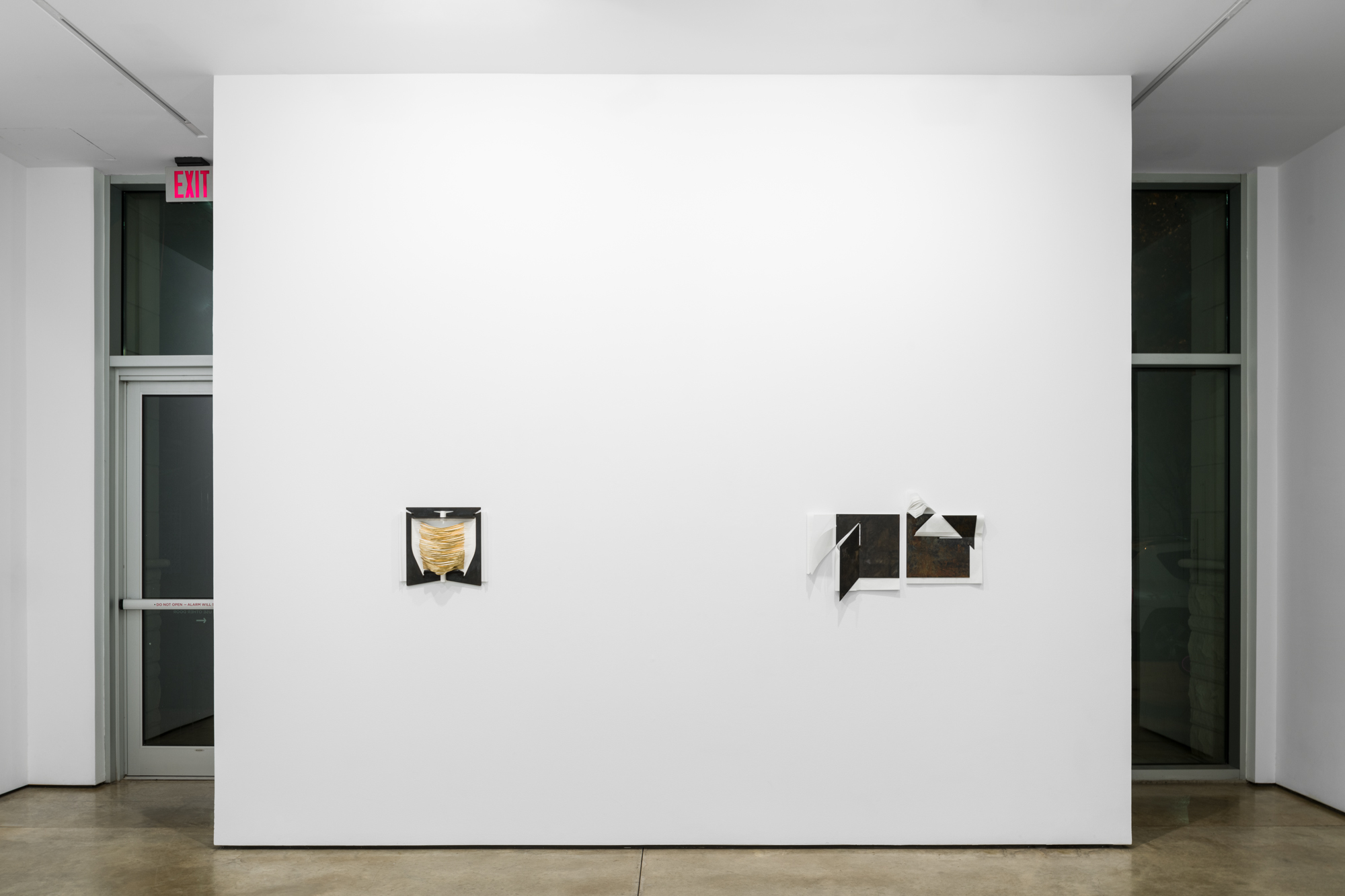
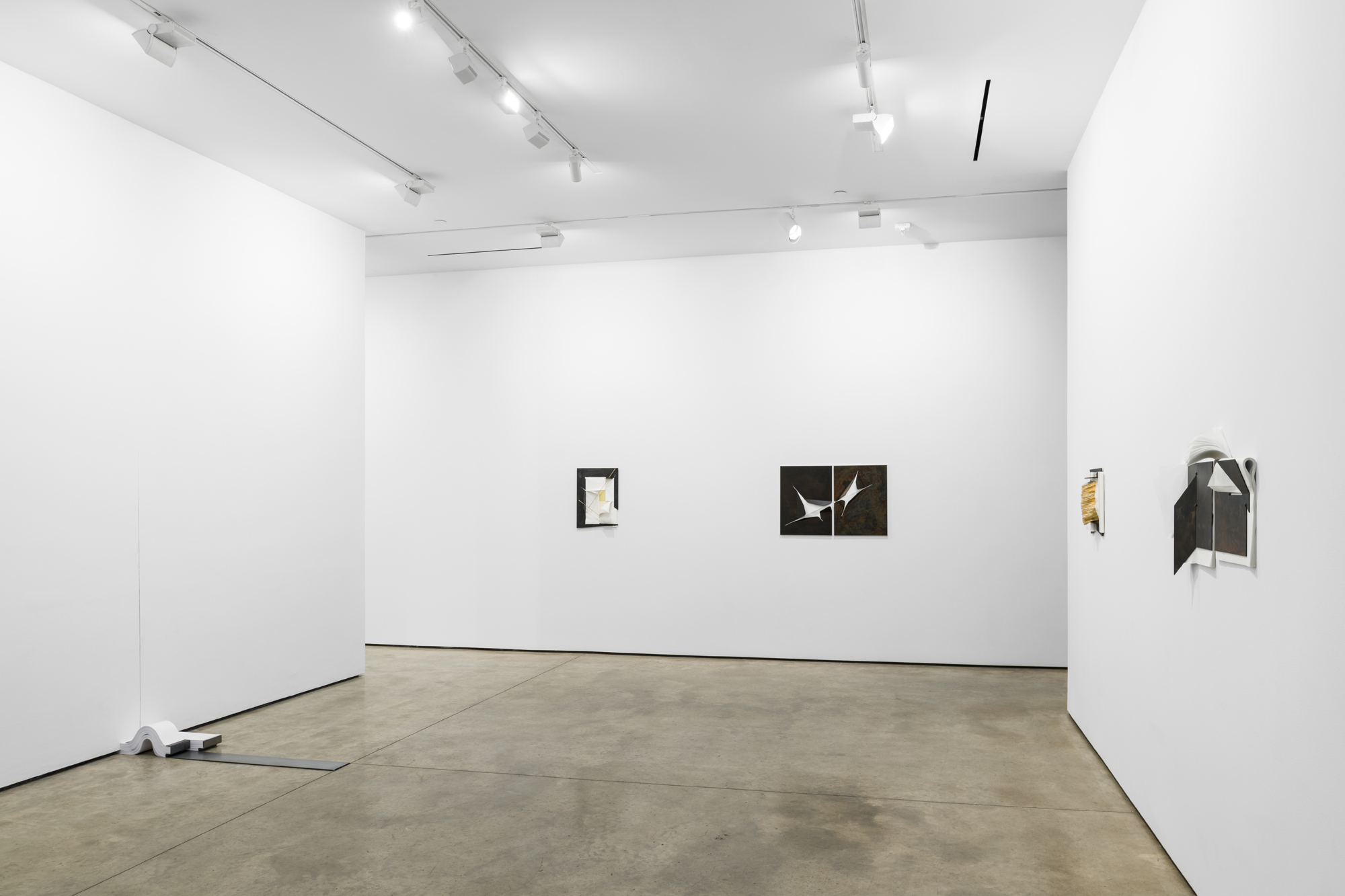


exhibition views, Lora Reynolds Gallery, Austin, Texas, November 2019
(Portuguese text below)
Lucas Simões thinks of his new works as drawings, even though they carry no graphite and have some dimensionality. He draws with an industrial laser, cutting angular or curved shapes (reminiscent of Brutalist architecture) into blackened steel plates, essentially turning them into elaborate paperclips that pinch, pull, and compress his trademark stacks of tracing paper. He slices into each stack to make its sheets spread apart or curl back onto themselves. Screws pierce both the steel and the paper—from the front—simultaneously holding the artworks together and fixing them to the wall. The new drawings hang in precarious tension, as do Simões’s previous concrete and paper Abismo sculptures.
Before he found art-making, Simões was an architect. He worked on commercial projects as part of a large team and designed and built residential projects on his own. He made architectural drawings in AutoCAD, the same software he uses to draw plans for his artworks now. Before the pieces in this show were realized (when they existed only on his computer screen), the line separating them from architectural drawings, in Simões’s mind, was faint. They could have just as easily become rooms, spaces, buildings. But by pushing their final form toward drawing instead of architecture, Simões is grasping for a type of poetic purity that was hard to come by when he was designing buildings. His architectural practice was mired in compromise, tempering beautiful dreams with practicality. The negotiations that define his art-making practice, however, he undertakes directly with his materials.
Metal sheets , concrete, tracing paper, brass, gold leaf, rebar, insulating sheathing—the materials Simões works with all have minds of their own. His constructions never turn out exactly like their blueprints stipulate (the same goes for buildings), no matter how precisely he follows his plans. Pulling molds off his concrete forms once they dry, Simões sometimes finds surprising surface textures or colors. He usually needs to revise the plans for his metal plates after building a mock-up—to adjust the direction or amount of tension the plate applies to the paper it holds. A large stack of tracing paper with a slice through its middle, when suspended vertically, will drape differently than a smaller but otherwise identical stack. And once his work in the studio is complete, installing his drawings/sculptures in the gallery always requires unexpected adjustments to find their perfect balance points.
Balance, tension, unpredictability, adjusting expectations—the defining features of Lucas Simões’s artwork point as much to the process and beauty of making buildings as to that of building a relationship, a life, with another human being. The paper in this show often takes on figurative (maybe even sensual) qualities: spreading, bending, teasing, exposing, demurring. Drawing is a more primordial art form than sculpture. It is more direct; it removes a measure of mediation between an object and its conception. Simões’s new drawings bring us closer to the early lives of his artworks (as digital renderings no one but the artist ever sees), closer to his first love (architecture), closer to the inside of his mind, and perhaps even to his experience of eros."
text by Colin Doyle
Lucas Simões thinks of his new works as drawings, even though they carry no graphite and have some dimensionality. He draws with an industrial laser, cutting angular or curved shapes (reminiscent of Brutalist architecture) into blackened steel plates, essentially turning them into elaborate paperclips that pinch, pull, and compress his trademark stacks of tracing paper. He slices into each stack to make its sheets spread apart or curl back onto themselves. Screws pierce both the steel and the paper—from the front—simultaneously holding the artworks together and fixing them to the wall. The new drawings hang in precarious tension, as do Simões’s previous concrete and paper Abismo sculptures.
Before he found art-making, Simões was an architect. He worked on commercial projects as part of a large team and designed and built residential projects on his own. He made architectural drawings in AutoCAD, the same software he uses to draw plans for his artworks now. Before the pieces in this show were realized (when they existed only on his computer screen), the line separating them from architectural drawings, in Simões’s mind, was faint. They could have just as easily become rooms, spaces, buildings. But by pushing their final form toward drawing instead of architecture, Simões is grasping for a type of poetic purity that was hard to come by when he was designing buildings. His architectural practice was mired in compromise, tempering beautiful dreams with practicality. The negotiations that define his art-making practice, however, he undertakes directly with his materials.
Metal sheets , concrete, tracing paper, brass, gold leaf, rebar, insulating sheathing—the materials Simões works with all have minds of their own. His constructions never turn out exactly like their blueprints stipulate (the same goes for buildings), no matter how precisely he follows his plans. Pulling molds off his concrete forms once they dry, Simões sometimes finds surprising surface textures or colors. He usually needs to revise the plans for his metal plates after building a mock-up—to adjust the direction or amount of tension the plate applies to the paper it holds. A large stack of tracing paper with a slice through its middle, when suspended vertically, will drape differently than a smaller but otherwise identical stack. And once his work in the studio is complete, installing his drawings/sculptures in the gallery always requires unexpected adjustments to find their perfect balance points.
Balance, tension, unpredictability, adjusting expectations—the defining features of Lucas Simões’s artwork point as much to the process and beauty of making buildings as to that of building a relationship, a life, with another human being. The paper in this show often takes on figurative (maybe even sensual) qualities: spreading, bending, teasing, exposing, demurring. Drawing is a more primordial art form than sculpture. It is more direct; it removes a measure of mediation between an object and its conception. Simões’s new drawings bring us closer to the early lives of his artworks (as digital renderings no one but the artist ever sees), closer to his first love (architecture), closer to the inside of his mind, and perhaps even to his experience of eros."
text by Colin Doyle
![As Built, 2019 [paper, steel and intervention on wall] 140 x 140 x 30 cm](https://freight.cargo.site/t/original/i/82d28601c5c25b472da2716700dbd8db85ac94588e89e0852752c5d3d26006e5/_DSC4497.jpg)
As Built, 2019
papel, aço e intervenção em parede
paper, steel and intervention on wall
site specific
140 x 140 x 30 cm


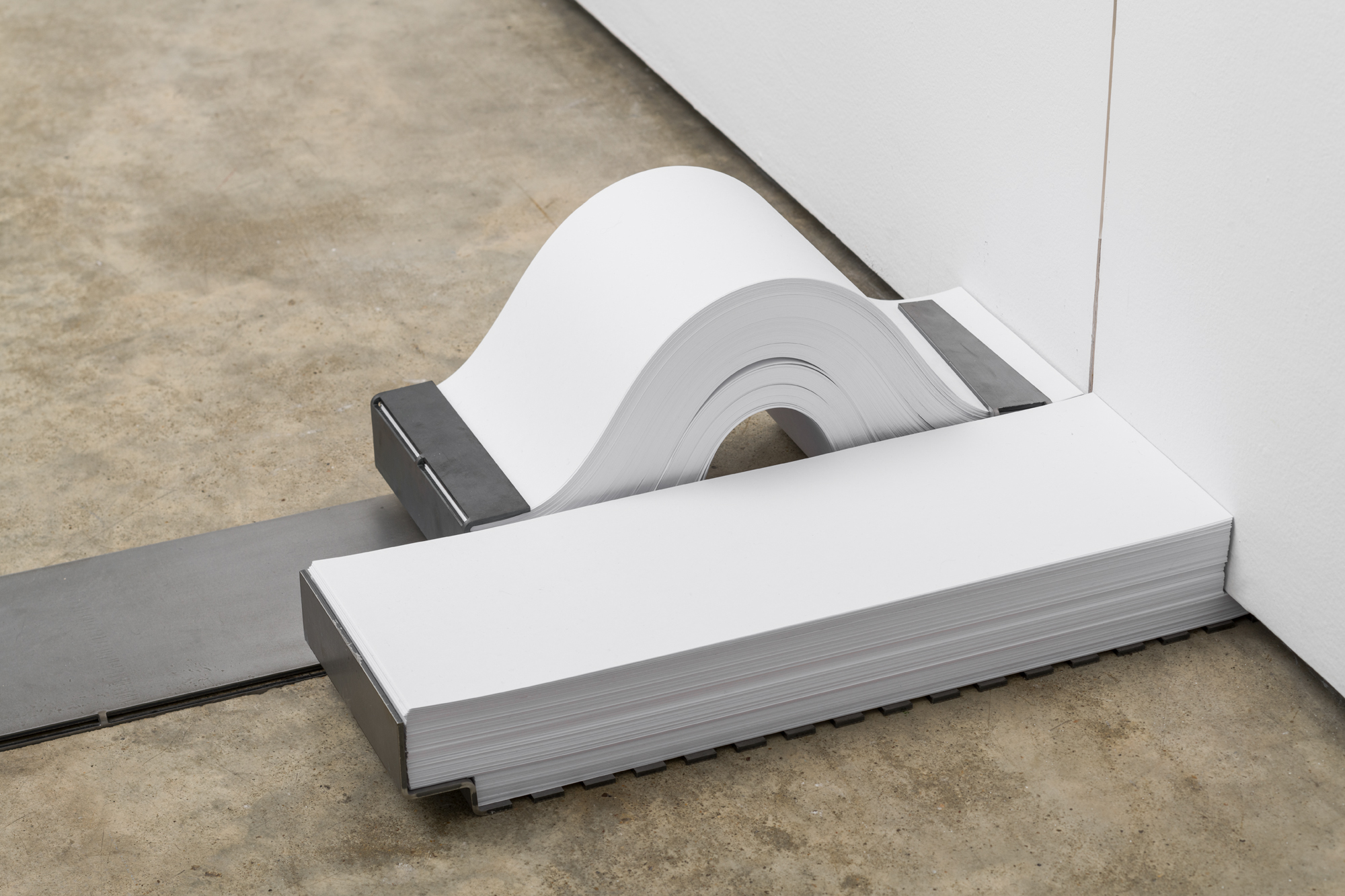

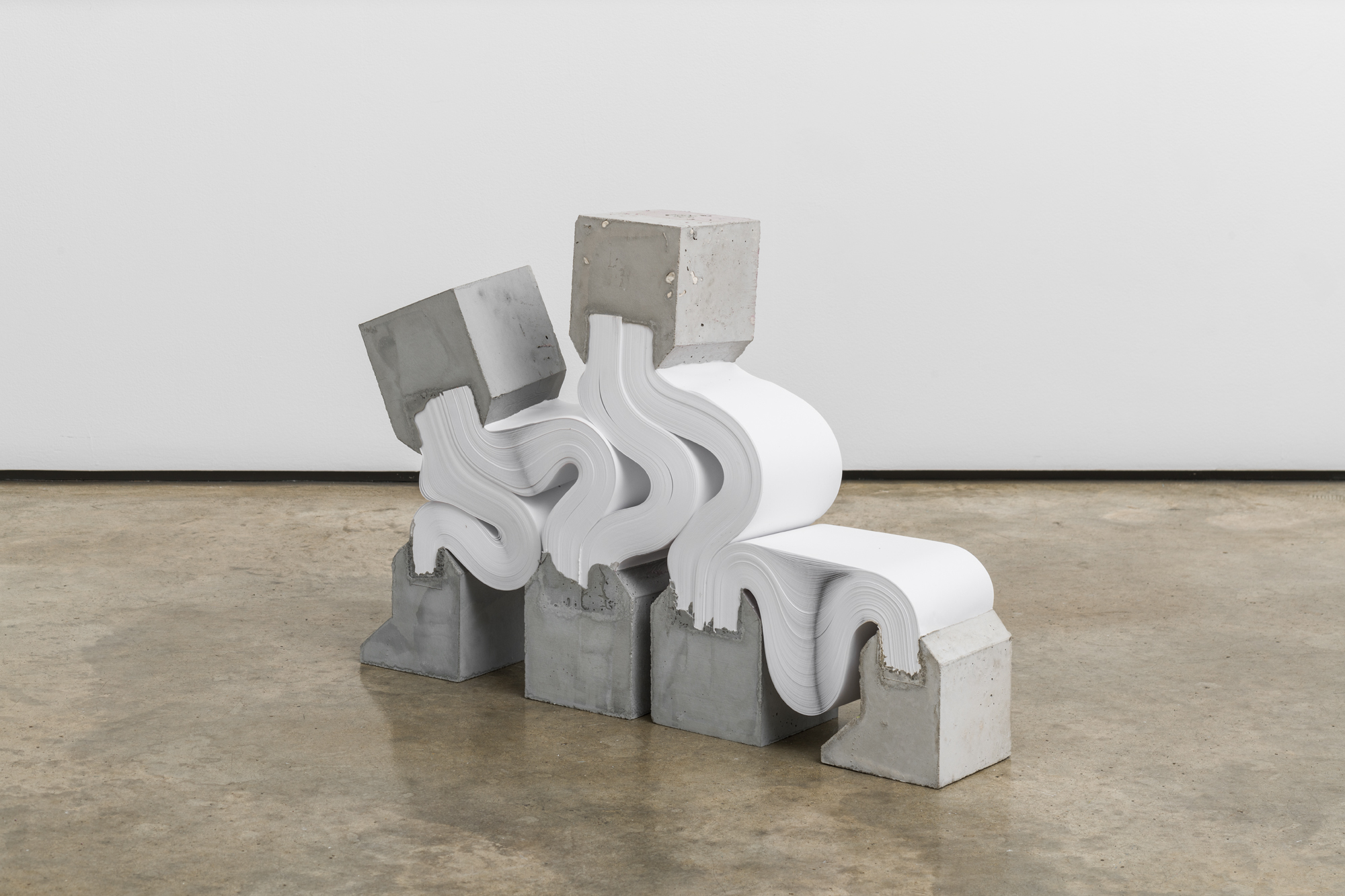

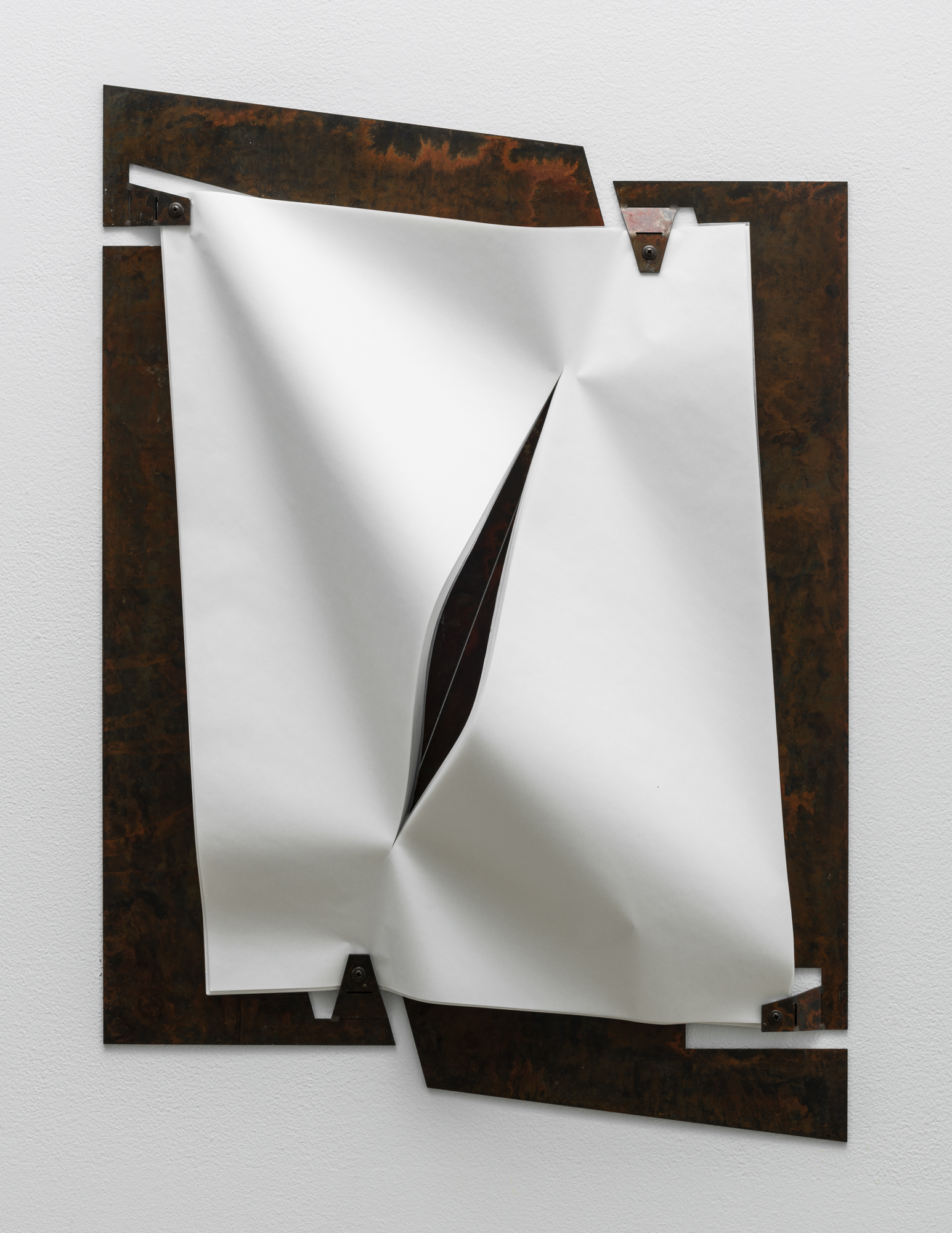




Texto em português
Lucas Simões enxerga seus trabalhos como desenhos, mesmo que eles não carreguem traços de grafite e tenham uma certa tridimensionalidade. Desenha em chapas de aço pretas com um laser industrial, recortando formas curvas ou anguladas (reminiscências da arquitetura brutalista), transformando-as em elaborados clipes de papel que beliscam, puxam e comprimem suas características pilhas de papel manteiga. Os cortes que sulcam as pilhas fazem o papel se abrir ou encurvar sobre si mesmo. Os parafusos prendem tanto o papel quando as chapas simultaneamente, pela frente, segurando a peça e prendendo-a à parede. Os novos desenhos são suspensos numa tensão precária, assim como os trabalhos anteriores de concreto e papel de Simões, as esculturas da série Abismo.
Antes de dedicar-se à arte, Simões atuava como arquiteto. Trabalhou em projetos comerciais participando de equipes e realizou projetos residenciais individuais. Os desenhos eram realizados em AutoCAD, o mesmo software usado para desenhar suas obras agora. A linha que distinguia as peças desta esta exposição antes de serem realizadas (quando apenas existiam em sua tela de computador) de projetos arquitetônicos, na mente de Simões, era tênue. Poderiam facilmente ter se tornado cômodos, espaços, edifícios. Mas apenas conduzindo sua forma final para o desenho ao invés que para a arquitetura, Simões alcança uma pureza poética difícil de impetrar quando desenhava edifícios para seus clientes. Sua pratica de arquitetura era limitada pelo compromisso, mitigando sonhos pela realidade. As negociações que definem sua pratica como artista, ao contrario, são diretamente ligadas a seus materiais.
Chapas metálicas, concreto, papel manteiga, latão, folha de ouro, vergalhões, camadas isolantes – os materiais que Simões usa em sua obra tem suas próprias identidades. Seus trabalhos quase nunca saem exatamente como seus projetos previam (assim como acontece com as construções), não importa quão precisamente são seguidos os desenhos. Ao retirar os moldes uma vez que o concreto secou, Simões se depara as vezes com texturas e cores inesperados. É comum que os desenhos das chapas metálicas precisem de revisão após realizar os testes – ajustar a direção ou a quantidade de pressão que a chapa concentra no papel que segura. Uma grande pilha de papel manteiga incisa em seu meio, quando suspensa, irá se encurvar diferentemente de uma pilha menor. E assim que o trabalho de ateliê se conclui, instalar seus desenhos/esculturas na galeria demanda ajustes inesperados ao alcançar o equilíbrio perfeito.
Equilíbrio, tensão, imprevisibilidade, afinar expectativas – as características que definem o trabalho de Lucas Simões apontam tanto ao processo e a beleza de realizar edificações como à construção de relações, a vida com outro ser humano. O papel, nesta exposição, assume frequentemente qualidades figurativas (quem sabe sensuais): se abrindo, dobrando, provocando, expondo, hesitando. O desenho é uma arte mais primordial que a escultura. É mais direto, remove uma certa interferência entre o objeto e sua própria concepção. Os novos desenhos de Simões nos aproximam dos embriões de seus trabalhos (desenhos digitais que apenas o artista vê), de seu primeiro amor (a arquitetura), de sua mente e talvez, de sua experiência com o eros.
Texto de Colin Doyle
Lucas Simões enxerga seus trabalhos como desenhos, mesmo que eles não carreguem traços de grafite e tenham uma certa tridimensionalidade. Desenha em chapas de aço pretas com um laser industrial, recortando formas curvas ou anguladas (reminiscências da arquitetura brutalista), transformando-as em elaborados clipes de papel que beliscam, puxam e comprimem suas características pilhas de papel manteiga. Os cortes que sulcam as pilhas fazem o papel se abrir ou encurvar sobre si mesmo. Os parafusos prendem tanto o papel quando as chapas simultaneamente, pela frente, segurando a peça e prendendo-a à parede. Os novos desenhos são suspensos numa tensão precária, assim como os trabalhos anteriores de concreto e papel de Simões, as esculturas da série Abismo.
Antes de dedicar-se à arte, Simões atuava como arquiteto. Trabalhou em projetos comerciais participando de equipes e realizou projetos residenciais individuais. Os desenhos eram realizados em AutoCAD, o mesmo software usado para desenhar suas obras agora. A linha que distinguia as peças desta esta exposição antes de serem realizadas (quando apenas existiam em sua tela de computador) de projetos arquitetônicos, na mente de Simões, era tênue. Poderiam facilmente ter se tornado cômodos, espaços, edifícios. Mas apenas conduzindo sua forma final para o desenho ao invés que para a arquitetura, Simões alcança uma pureza poética difícil de impetrar quando desenhava edifícios para seus clientes. Sua pratica de arquitetura era limitada pelo compromisso, mitigando sonhos pela realidade. As negociações que definem sua pratica como artista, ao contrario, são diretamente ligadas a seus materiais.
Chapas metálicas, concreto, papel manteiga, latão, folha de ouro, vergalhões, camadas isolantes – os materiais que Simões usa em sua obra tem suas próprias identidades. Seus trabalhos quase nunca saem exatamente como seus projetos previam (assim como acontece com as construções), não importa quão precisamente são seguidos os desenhos. Ao retirar os moldes uma vez que o concreto secou, Simões se depara as vezes com texturas e cores inesperados. É comum que os desenhos das chapas metálicas precisem de revisão após realizar os testes – ajustar a direção ou a quantidade de pressão que a chapa concentra no papel que segura. Uma grande pilha de papel manteiga incisa em seu meio, quando suspensa, irá se encurvar diferentemente de uma pilha menor. E assim que o trabalho de ateliê se conclui, instalar seus desenhos/esculturas na galeria demanda ajustes inesperados ao alcançar o equilíbrio perfeito.
Equilíbrio, tensão, imprevisibilidade, afinar expectativas – as características que definem o trabalho de Lucas Simões apontam tanto ao processo e a beleza de realizar edificações como à construção de relações, a vida com outro ser humano. O papel, nesta exposição, assume frequentemente qualidades figurativas (quem sabe sensuais): se abrindo, dobrando, provocando, expondo, hesitando. O desenho é uma arte mais primordial que a escultura. É mais direto, remove uma certa interferência entre o objeto e sua própria concepção. Os novos desenhos de Simões nos aproximam dos embriões de seus trabalhos (desenhos digitais que apenas o artista vê), de seu primeiro amor (a arquitetura), de sua mente e talvez, de sua experiência com o eros.
Texto de Colin Doyle
